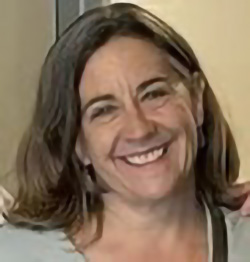Jerry’s Place: A Social Model Hospice
by Alyssa Erikson, PhD, RN, CNE
California State University, Monterey Bay, located near the state’s central coast, is a long-term campus partner of the CSU Shiley Haynes Institute for Palliative Care. I have served as the faculty director and am involved with various palliative care initiatives on our campus and surrounding community. One such initiative I would like to highlight is Jerry’s Place, a program through the Jerry Rubin Foundation for Cancer Care. Jerry’s Place is a social model hospice that provides a furnished private room and around the clock caregiving to people at the end of life. It honors the care and compassion Dr. Rubin gave throughout his life as a beloved oncologist in the Monterey region.

I am part of the planning group comprised of local clinicians that envisioned Jerry’s Place. With a $200,000 grant from Hospice Giving Foundation, Jerry’s Place accepted its first resident in late December 2022 and has served 10 residents since that time. It can accommodate up to two residents at a time. The grant funding has allowed Jerry’s Place to provide services free of charge and not turn away anyone due to an inability to pay.
Connie Riley, MA, is the Program Manager for Jerry’s Place. She has worked as a chaplain, including in hospice spiritual care for 8 years. I recently sat down with her for an interview to find out more about Jerry’s Place.
Tell us about Jerry’s Place as a social model hospice.
Most people don’t know this, but the Medicare Hospice benefit doesn’t include room and board. Social model hospice helps to bridge this gap and provides a safe, comfortable place with caregiving for people at the end of life in conjunction with a hospice agency that provides medical and nursing care. Most social model hospices are free-standing homes. Jerry’s Place has a unique partnership with a local Assisted Living facility and we contract two rooms to cover what the Medicare benefit doesn’t cover. Residents in hospice care receive a private room and caregiving services. But more than just providing room and board, Jerry’s Place gives an added layer of support at the end of life, especially in emotionally processing death and dying and navigating the hospice system.
Over the past year that Jerry’s Place has been opened, how have you seen it help people and families?

We fill a critical need by providing time and space to process and prepare for imminent death. This is especially important for people who were the sole caregiver for their loved one. It has allowed for an acceptance that treatment is no longer curative or in their best interest. After people realize that, I’ve seen that they’re more capable of transitioning with a sense of acceptance and peace.
I recently visited a resident whose adult children were sitting at his bedside listening to stories from his life. They were present. Because of Jerry’s Place, they were able to focus on closure in the final days of life instead of worrying about the stress of around the clock caregiving.
Jerry’s Place helps with the financial burden of caregiving which is oftentimes prohibitively expensive. Rarely do families have the means to fully (and even minimally) fund the caregiving that’s needed with a terminal illness. Jerry’s Place alleviates the concern of costs and this enables families to be with each other.
What do you envision for the next year for Jerry’s Place?
I would like to develop and build on our partnerships with the health science programs in our area, like nursing and social work at CSUMB. I envision a schedule filled with people who are available to vigil at the bedside when residents are transitioning, particularly those who do not have friends or family to sit with them. If we can develop the quality of “being with” people who are dying rather than “doing for” them, it would be a huge benefit to their professional development, as well as how different cultural and religious groups approach death and dying. It causes a real paradigm shift in health professional’s thinking from regarding death as a failure to accepting what is unavoidable. I hope in the next year, we’re able to generate greater awareness about social model hospices and how they address the gap with the Medicare benefit. I also would love to see how Jerry’s Place can help decrease the fear around death and dying and show how transitioning can be done with peace and dignity.




